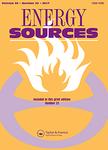版权所有:内蒙古大学图书馆 技术提供:维普资讯• 智图
内蒙古自治区呼和浩特市赛罕区大学西街235号 邮编: 010021

作者机构:Cyprus Int Univ Energy Syst Engn Dept Haspolat Lefkosa Turkey Univ Elect Sci & Technol China Sch Mech & Elect Engn Chengdu Sichuan Peoples R China Guangdong Univ Petrochem Technol Sch Econ & Management Maoming Peoples R China Cyprus Int Univ Environm Sci Dept Haspolat Lefkosa Turkey Univ Elect Sci & Technol China Sch Software Engn Chengdu Peoples R China
出 版 物:《ENERGY SOURCES PART A-RECOVERY UTILIZATION AND ENVIRONMENTAL EFFECTS》 (Energy Sources Recovery Util. Environ. Eff.)
年 卷 期:2021年第47卷第1期
页 面:7480-7498页
核心收录:
学科分类:0820[工学-石油与天然气工程] 0830[工学-环境科学与工程(可授工学、理学、农学学位)] 0817[工学-化学工程与技术] 08[工学] 0807[工学-动力工程及工程热物理]
主 题:PV specific yield machine learning python meteorological parameters regression algorithm
摘 要:The deployment of photovoltaic technology in global electricity generation has reduced the dependence on fossil fuels and the adverse effect of global warming climate changes. However, the variability of PV output due to its reliance on meteorological parameters hinders the total maximization of the technology. In this paper, the interdependence of meteorological parameters on accurate estimation of the specific yield of the PV system is examined using machine learning algorithms. The analysis uses 2 years of meteorological data in a 10-min interval. The meteorological parameters used as input are global solar radiation (GR), wind speed (WS), wind direction (WD), the standard deviation of wind direction (WSD), air temperature (AT), and relative humidity (RH), while the output variable is the PV specific yield (PVSY). This study uses a Python-based all regressor machine learning algorithm, to analyze their accuracy for the estimation analysis at different input feature space. The accuracy of the models and algorithms is analyzed using mean absolute error (MAE), mean square error (MSE), root mean square error (RMSE), and coefficient of correlation (R-2). The best performance in the two feature space was retrieved for AT, and GR with MSE and MAE values of 0.113 and 0.252, respectively. The best performance in the three feature space was retrieved for WSD, AT, and GR with MSE and MAE values of 0.109 and 0.255, respectively. The results show that the most accurate PVSY estimation was for the four input feature space with input variables of WS, AT, GR, and RH. The K-nearest neighbor (KNN) proved to be the most appropriate algorithm for this feature space with an RMSE and MAE score of 0.101 and 0.266, respectively. The study also shows that the most significant meteorological inputs in PV yield estimation are air temperature and global solar radiation. The study also noted that a large feature space adds uncertainties to the training process. Finally, the paper concludes